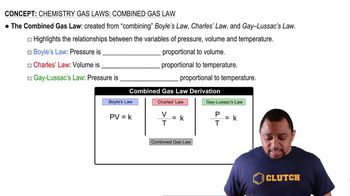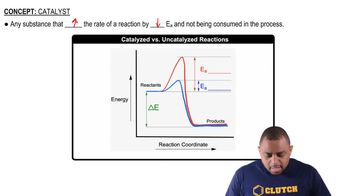An 11.5-mL sample of liquid butane (density = 0.573 g/mL) is evaporated in an otherwise empty container at a temperature of 28.5 °C. The pressure in the container following evaporation is 892 torr. What is the volume of the container?

A catalytic converter in an automobile uses a palladium or platinum catalyst (a substance that increases the rate of a reaction without being consumed by the reaction) to convert carbon monoxide gas to carbon dioxide according to the reaction: 2 CO(g) + O2(g) → 2 CO2(g) A chemist researching the effectiveness of a new catalyst combines a 2.0:1.0 mole ratio mixture of carbon monoxide and oxygen gas (respectively) over the catalyst in a 2.45-L flask at a total pressure of 745 torr and a temperature of 552 °C. When the reaction is complete, the pressure in the flask has dropped to 552 torr. What percentage of the carbon monoxide was converted to carbon dioxide?
 Verified step by step guidance
Verified step by step guidance
Verified video answer for a similar problem:
Key Concepts
Stoichiometry

Gas Laws

Catalysis

A scuba diver creates a spherical bubble with a radius of 2.5 cm at a depth of 30.0 m where the total pressure (including atmospheric pressure) is 4.00 atm. What is the radius of the bubble when it reaches the surface of the water? (Assume that the atmospheric pressure is 1.00 atm and the temperature is 298 K.)
A quantity of N2 occupies a volume of 1.0 L at 300 K and 1.0 atm. The gas expands to a volume of 3.0 L as the result of a change in both temperature and pressure. Find the density of the gas at these new conditions.
A mixture of CO(g) and O2(g) in a 1.0-L container at 1.0×103 K has a total pressure of 2.2 atm. After some time, the total pressure falls to 1.9 atm as the result of the formation of CO2. Determine the mass (in grams) of CO2 that forms.
The radius of a xenon atom is 1.3×10– 8 cm. A 100-mL flask is filled with Xe at a pressure of 1.0 atm and a temperature of 273 K. Calculate the fraction of the volume that is occupied by Xe atoms. (Hint: The atoms are spheres.)
